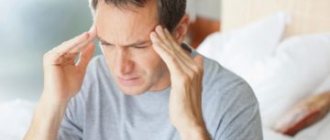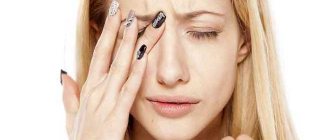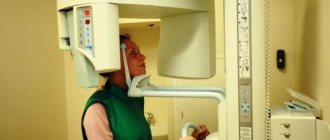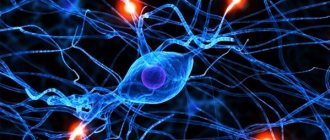When a headache occurs on one side and the syndrome spreads to the eye area, the person’s general condition worsens significantly. After all, such a symptom is always so unpleasant and painful that it prevents you from concentrating on work and distracts all attention, forcing you to constantly look for ways and means to eliminate it.
Such a sign may have several reasons and indicate serious pathological processes occurring inside the body.
In addition, it can serve as a precursor and warning signal to the onset of the development of some serious illness.
In general, it is very important to promptly identify the cause of such pain and not just get rid of it, but to cure and stop the development of negative processes within the body.
What to do if there is pressure on your eyes
Medicines, traditional recipes and special exercises help eliminate pressing discomfort in the eye area. The main thing is to carry out treatment under the supervision of a doctor.
Medicines
The goal of drug therapy is to eliminate the underlying disease and alleviate the patient’s condition. Depending on the cause of eye pain, several groups of pharmaceutical drugs are used.
Ibuprofen can be taken as a pain reliever
- Pain relievers and inflammation relievers - Analgin, Ibuprofen, Diclofenac.
- Antibiotic drugs – Cephalexin, Amoxicillin.
- Diuretics – Furosemide, Diacarb.
- Sedatives – Novopassit, Fitosed, Valerian.
- Eye drops:
- to reduce the production of intraocular secretions - Bitoptik, Azopt, Timolol;
- for stable outflow of fluid and constriction of the pupil - Pilocarpine;
- to reduce inflammation - Diclofenac.
Medicines are selected based on the individual characteristics of the patient - weight, age, presence of chronic diseases.
Treatment with folk remedies
You can relieve the condition of pressing headaches that radiate to the eyes using traditional medicine methods.
Herbal compresses
Using herbal infusions will relieve eye pain
Combine equal amounts of nettle, chamomile, lily of the valley, pour boiling water (2 tablespoons of raw material per 1 liter of water), simmer over low heat for 5 minutes, cool. Soak cotton pads in the strained broth and apply to eyes. The duration of the procedure is 3–5 minutes.
Melissa tea for migraines
You can drink lemon balm tea to relieve migraines.
Brew 2 tsp in 400 ml of boiling water. chopped herbs, leave for 10 minutes. Tea helps to subside a migraine attack and relieves pressing discomfort in the eyes.
Collection of herbs for washing eyes
Herbal collection including golden mustache for washing eyes
In equal quantities (1 tsp each), take golden mustache, chamomile, aloe leaves, place in an enamel container and pour 1 liter of boiling water, simmer over low heat for 7 minutes. Rinse your eyes with the cooled broth. Therapeutic actions are carried out with a cotton pad soaked in the prepared decoction. Do at least 4 procedures per day.
Compresses with essential oils
Dissolve chamomile and peppermint oils (3 drops each) in 500 ml of warm water, moisten a towel in the liquid and apply to the eyes for 10–15 minutes. The temporal area is treated with essential extracts - the procedure soothes and relieves pain.
Healing potion with honey and wine
Wine can be consumed with honey to relieve eye inflammation
Dissolve 5 tbsp in 1 glass of red wine. l. honey and 20 ml aloe juice. The product is drunk three times a day, 1 tsp.
Golden mustache tincture
Grind the leaves of the plant, fill a small jar (0.5 l) 2/3 full with the raw material, pour in 400 ml of vodka. Close the liquid tightly with a lid and leave for 10 days in a dark place, shaking occasionally. The medicine is taken 35 drops before meals 1 time per day.
Potato lotions
Grind 3 peeled potatoes, spread the resulting pulp on the frontal area, covering with a cloth and cellophane. Keep the compresses on your head for 15–20 minutes. The product quickly relieves pain and reduces the feeling of squeezing in the eyes.
Potato pulp compress relieves eye strain
Traditional recipes are auxiliary methods in the complex fight against the underlying disease that provokes eye pain. Their use enhances the therapeutic effect of pharmaceutical drugs.
Eye exercises
In addition to treatment with medications and folk remedies, perform special exercises for the eyes. Its task is to strengthen the eye muscles, relieve tension, fatigue, and heaviness.
Eye exercises that should be performed even in the absence of pain to prevent fatigue
Complex gymnastics consists of 5 exercises that are performed in a sitting position (head straight, only eyes moving).
- Move your eyes from side to side 7–10 times. Lower your eyelids, exhale and repeat the exercise 2-3 times.
- Alternately raise and lower your open eyes 6 times. After a 5 second break, close your eyelids and perform a similar manipulation.
- Relax, close your eyes. Try to mentally draw wavy lines towards yourself, away from you and to the sides with your eyeballs. Do 5-7 movements in each case.
- With your eyes (first open, then closed) draw a figure eight in the air in a vertical and horizontal position - 7 times.
- Draw a circle with your eyes, starting from the right corner of the room, then draw a circle in the middle of the room, finish the exercise by drawing an imaginary triangle.
The positive effect of eye exercises is achieved only if the exercises are performed regularly. Daily exercise helps to quickly and permanently eliminate unpleasant discomfort.
Basic methods of alternative therapy
There are several common and very effective methods of alternative medicine, which in a few sessions can eliminate headaches and eye pain that appear with some regularity.
These methods include the following:
- Massage. It should only be done by a qualified specialist. Massage helps the muscular system to relax, nervous tension also goes away, and at the same time the intensity of pain in the head and eyes decreases. Several massage sessions are often enough to make the headache disappear for a long time.
- Acupuncture or acupuncture is a method of Chinese medicine in which biologically active points of the body are irritated with needles or heat. Numerous studies and patient reviews indicate that the frequency and intensity of attacks of pain in the head and eyes is significantly reduced after this procedure.
- Taking mineral and biologically active supplements. This method of traditional medicine can be very effective due to the presence in these preparations of natural elements, the lack of which is experienced by the human body, and this deficiency manifests itself through periodic headaches and eye pain.
- Meditation is also a Chinese medicine technique that helps relax muscles and relieve nervous tension.
- “Playing with the eyes” is an exercise for the eyes (squinting, blinking, etc.), relaxing the muscles of the ocular system, improving vision and the general condition of the eyes.
- Breathing exercises. This method helps improve the process of feeding the brain, saturating it with oxygen, improves blood circulation in the brain, improves visual acuity and improves overall well-being.
Causes
Attention! Eye fatigue can occur not only when watching TV or while working at the computer. Any prolonged strain on the eyes leads to this condition.
. In addition, asthenopia can be caused by a number of other factors that at first glance are not related to ophthalmology:
In addition, asthenopia can be caused by a number of other factors that at first glance are not related to ophthalmology:
- Long (more than 3-4 hours) reading , and the format does not matter: it can be either traditional paper media or information in electronic form.
- Poor lighting of the workplace , in this case it can be not only a lack of light, but also an incorrect placement of its sources . But too much lighting also has a negative effect on the visual organs, tiring them. The best option is natural light (for this, the desktop should be located opposite the window). But if this is not possible, you should try to at least use medium-power lamps and install them so that they create background rather than direct lighting.
- Incorrectly selected optics for vision correction. If you select glasses or lenses together with a specialist, such problems arise extremely rarely and can be resolved very quickly.
- Headaches and migraines.
- Dry eye syndrome, which occurs as a result of prolonged exposure to too dry air. This pathology leads to fatigue, as the protective tear film of the visual organs becomes thinner, and without such a layer they begin to experience discomfort.
- Hormonal changes in the body that occur during pregnancy or adolescence can contribute to disruptions in the functioning of many glands, including those that secrete tear secretions. But in the worst case, such hormonal disruptions can lead to dysfunction of the endocrine gland, as a result of which the eyes not only become tired and fatigued, but also a decrease in visual acuity.
- The eyes often get tired of drivers who spend many hours behind the wheel, without taking their eyes off the road and carefully concentrating on what is happening. This leads to eye strain, and we cannot exclude such an additional external factor as exposure to sunlight on the visual organs during a trip.
- Vegetative-vascular dystonia . With this pathology, blood pressure is often unstable, decreasing or increasing, and this negatively affects the vascular system (including the vessels of the eyeballs).
- Increased intracranial and intraocular pressure . In any of these cases, a load can be created on the eyeballs, which are subject to compression, so if eye fatigue is accompanied by pain, it is necessary to check the IOP level.
- Prolonged stays in rooms with heaters or air conditioners turned on . Such devices dry out the air, which also affects the tear lining of the eye.
- Osteochondrosis or excessive tension in the cervical spine. In such cases, systemic blood flow in the vertebral arteries may be disrupted, and it is this that supplies oxygen to the brain and organs of vision. Considering that the optic nerves are directly fed from the brain, with such hypoxia (lack) the connection between the eyes and the nervous system is disrupted, and this leads to the need for the eye tissues to work more intensively, which leads to fatigue.
- Lack of proper nutrition . We are talking not only about an excess of unhealthy food in the diet, but also about the lack of vitamins and microelements that have a beneficial effect on the visual system (in particular, potassium, polyunsaturated fatty acids, as well as vitamins A, C, B and AT 2). Without these substances, the functionality of the visual organs is impaired.
- Eye fatigue is a natural reaction to any surgery or drug treatment. During the post-rehabilitation period, any, even the most insignificant visual stress will always cause eye fatigue.
External reasons
During the consultation, the specialist will ask the person in detail exactly how his head hurts, whether there is irradiation into the eyes, and whether there is a relationship with external negative stimuli.
Provoking factors:
• prolonged exposure to a computer monitor, especially without the use of protective equipment, for example, special glasses;
• often the reason that a person has a headache and feels like sand has been poured into his eyes is wearing the wrong glasses or dirty lenses - at the slightest discomfort, if it intensifies, as soon as the person puts on glasses, it is necessary to correct the diopters or change the lenses;
Causes
Normal eye pressure ranges from eight to twenty-six millimeters of mercury. With such indicators, a person feels comfortable, and the eye is not subject to unnecessary stress. However, malfunctions often occur in the body, as a result of which the secretion of natural fluids of the eye increases, and the functioning of the heart and blood vessels is also disrupted, which leads to pressure surges. The cause of such failures can be stress, heavy stress (including mental stress), or a recent illness.
Another reason for increased intraocular pressure may be a change in the anatomical structure of the eye. The risk group includes people suffering from the following diseases:
- of cardio-vascular system
- atherosclerosis
- farsightedness
- having a hereditary predisposition
We recommend reading an article on a similar topic: Glaucoma - causes, symptoms, treatment.
Whether it is necessary to remove the epicanthus, you can find out in this publication:
General recommendations
The important point is not the fight against pain, even when the pain impulse radiates into the eyes, but the elimination of the cause of such symptoms.
General recommendations:
1. Visit a specialist.
2. Undergo a comprehensive comprehensive examination.
3. Reconsider your own lifestyle.
4. Ensure a quality night's rest.
5. Adjust your diet - give up strong drinks, rich broths, many spices, sauces, preservatives, smoked meats.
6. Maintain adequate drinking regime.
7. Try to walk more in the fresh air.
8. Observe the work and rest schedule.
9. Master yoga or relaxation complexes.
10. Visit the pool and fitness room more often.
Compliance with the above fairly simple recommendations helps to avoid a state of insufficiency of oxygen and nutrients in the body, which will be an excellent prevention of various pathologies that cause pain in the eye, the back of the head, and severe discomfort in other parts of the body.
It is useful for people suffering from migraine attacks and hypertensive crises to keep a diary, which indicates the time of occurrence of unpleasant sensations, what caused them, and whether the recommended medications helped. At the slightest deterioration in health, for example, the vision in the eye has become worse, the headache has intensified, it is necessary to consult a specialist again.
Take the test
Do you read a lot?
I don’t read at all I rarely read, if something comes to hand I periodically read various literature I read a lot of different books
Irina: 2 days ago
| I recently watched a program on Channel One, they also talked about restoring vision and mentioned this drug. They say they have found a way to permanently restore vision, and it is sold at a discounted price for everyone. |
Evgeniya:
| Tell me, I’ve been making compresses from honey and dandelion, the reviews seem to be good, but it hasn’t helped me yet, how long should I take to do them? Should I just have surgery? |
Maria (Ophthalmologist - highest category):
| Irina, forget about dandelion, this is a useless method, and surgery is DANGEROUS, I recommend that you read this article on restoring vision, in the 21st century vision can be restored without surgery! |
What causes symptoms such as: burning eyes, headache
Below are diseases that match your symptoms.
foot and mouth disease
Foot and mouth disease is an acute infectious disease of a viral nature, which is characterized by vesicular erosive damage to the integumentary tissues (mainly the mucous membranes of the mouth and the skin of the extremities), accompanied by an intoxication syndrome.
Read more- Red eyes
- speech disorder
- swallowing disorder
- swollen lymph nodes
- abdominal pain
- dizziness
- chills
- salivation
- headache
- painful urination
- weakness
- diarrhea
- elevated temperature
- difficulty swallowing
- body aches
- intoxication
- muscle aches
- burning in the mouth
- redness of the conjunctiva
- redness of the oral mucosa
- small blisters on the mucous membranes in the mouth
- ulcers between fingers
- increased salivation
- difficulty speaking
- swelling of the oral mucosa
- pain when urinating
Sarcoidosis
Sarcoidosis is a non-infectious systemic inflammatory disease that can affect many organs and systems (in particular the lungs), characterized by the formation of granulomas in the affected tissues (this is one of the diagnostic signs of the disease, which is revealed by microscopic examination; limited foci of inflammation, in the form of a dense nodule of various sizes).
The lymph nodes, lungs, liver, spleen are most often affected, and less often - skin, bones, organ of vision, etc. Read more- photophobia
- polyuria
- poor appetite
- fever
- Red eyes
- feeling of heartbeat
- shortness of breath on exertion
- itchy skin
- rash
- dyspnea
- burning in the eyes
- stuffy nose
- night sweats
- swollen face
- swollen joints
- swollen lymph nodes
- sleep problems
- abdominal pain
- blindness
- blurred vision
- spots before eyes
- fatigue
- weight loss
- wheezing
- xerostomia
- anemia
- pale skin
- chest pain
- color vision disorder
- coma
- cough
- hot skin
- headache
- hearing loss
- heart fluttering
- high-pitched wheezing
- joint pain
- fatigue
- hair loss
- blurry vision
- confusion
- spasm
- myalgia
- nosebleed
- bad feeling
- lack of appetite
- numbness
- eyes hurt
- pain
- weakness
- dry mouth
- dry cough
- muscle pain
- pain in the heart area
- wheezing in the lungs
Eye injury
Eye injury can be caused by a foreign object or chemical entering the eye, and eye injury can also be caused by damage to the area around the eyes.
Read more- photophobia
- Red eyes
- severe blood loss
- burning in the eyes
- blindness
- pupils of different sizes
- blurred vision
- my eyes are watering
- bruises around the eyes
- contusion
- corneal scratch
- headache
- blurry vision
- eyes hurt
- itching
- sensitivity to light
- bleeding from the eyes
Allergy
An allergy is an immune system reaction to a foreign substance that is not normally harmful to your body.
These foreign substances are called allergens. These may include certain foods, pollen, or pet dander. Read more- rash on the genitals
- Red eyes
- stomach ache
- peeling skin
- itchy skin
- rash
- dyspnea
- sneeze
- burning in the eyes
- bloating
- stuffy nose
- irritation in the throat
- tongue swelling
- swelling
- abdominal pain
- vomit
- my eyes are watering
- watery stool
- blisters
- wheezing
- suffocation
- conjunctivitis
- cough
- dermatitis
- dry skin
- headache
- irritation of the nasal mucosa
- pain
- nausea
- diarrhea
- itching
- hearing impairment
- runny nose
- wheezing in the lungs
- hives
Farsightedness
Farsightedness (hyperopia) is a vision defect in which only distant objects are clearly visible, while close objects are poorly visible.
A type of ametropia. At the same time, visual impairment regarding objects near is now a key feature for the use of this name, that is, when a person does not see well at a distance, he can still be diagnosed with “farsightedness.” People who suffer only from age-related farsightedness (presbyopia) see well into the distance. Read more- burning in the eyes
- blurred vision
- dry eyes
- headache
- blurry vision
- eyes hurt
- pain
- strabismus
- eye fatigue
Cerebral aneurysms
Cerebral aneurysms are a pathology characterized by local protrusions of the walls of arterial cerebral vessels.
Read more- photophobia
- poor coordination of movements
- seizures
- stomach ache
- retardation of movements
- speech disorder
- numbness of the toe
- emotional lability
- blindness
- loss of consciousness
- pupils of different sizes
- dizziness
- blurred vision
- vomit
- weak muscles
- decreased attention
- drooping eyelids
- numbness of the finger
- headache
- fatigue
- blurry vision
- spasm
- lack of appetite
- numbness in legs
- numbness of the limbs
- eyes hurt
- pain
- pain in the neck
- weakness
- nausea
- sense of anxiety
- hearing impairment
- numbness of the face
- noise in ears
- sensitivity to light
- neck stiffness
Cluster headaches
Cluster headaches are a pronounced pain syndrome in the areas of projection of the brain onto the walls of the skull, occurring spontaneously and irregularly. The intensity of the pain is so great that it can lead to suicide attempts in order to get rid of the pain.
- poor coordination of movements
- Red eyes
- speech disorder
- stuffy nose
- blurred vision
- vomit
- my eyes are watering
- pale skin
- chronic pain
- red face
- headache
- irritability
- eyes hurt
- pain
- nausea
- cardiopalmus
- elevated temperature
- sweating
- runny nose
- sensitivity to light
Flu
Influenza is an acute respiratory tract infection caused by the influenza virus.
Included in the group of acute respiratory viral infections (ARVI). Periodically spreads in the form of epidemics and pandemics. For many people, flu symptoms go away without medical attention within a week. However, the flu can lead to severe illness and death, and people at risk need to be especially careful about this disease. Read more- photophobia
- fever
- seizures
- stomach ache
- dyspnea
- sneeze
- stuffy nose
- taste disorder
- a sore throat
- vomit
- my eyes are watering
- fatigue
- wheezing
- woozy
- chills
- cough
- hot skin
- hallucinations
- headache
- high-pitched wheezing
- joint pain
- fatigue
- myalgia
- nasal discharge
- nosebleed
- bad feeling
- lack of appetite
- pain
- weakness
- elevated temperature
- sweating
- runny nose
- muscle pain
- aching joints
Barley
Barley is an acute purulent inflammation of the hair follicle of the eyelash or the Zeiss sebaceous gland, which is located near the eyelash bulb.
Read more- photophobia
- poor appetite
- Red eyes
- burning in the eyes
- swollen lymph nodes
- my eyes are watering
- headache
- swelling of the eyelid
- eyes hurt
- weakness
- elevated temperature
- sensitivity to light
- itching of the eyelid
- redness of the eyelid
Asthenopia
Asthenopia is a disease associated with visual fatigue.
The problem manifests itself in the form of decreased visual acuity, intermittency of the objects being examined, a veil, a feeling of “sand in the eyes,” photophobia, etc. Most often, the patient complains of characteristic symptoms when working at close range, while the symptoms weaken during rest. Read more- photophobia
- Red eyes
- burning in the eyes
- dizziness
- blurred vision
- my eyes are watering
- headache
- fatigue
- eyes hurt
- decreased visual acuity
- pain in temples
Glaucoma
Glaucoma belongs to a group of eye diseases and is a chronic pathology.
This disease is characterized by a constant or periodic increase in intraocular pressure (IOP) to a level above the permissible level for humans, subsequent impairment of visual function, the development of optical neuropathy and optic nerve atrophy. Read more- photophobia
- bulging eyes
- Red eyes
- stomach ache
- blindness
- pupils of different sizes
- blurred vision
- vomit
- color vision disorder
- facial pain
- headache
- blurry vision
- eyes hurt
- pain
- nausea
Trichinosis
Trichinosis is an acute helminthiasis of mammals and humans from the group of nematodes.
A severe clinical picture is characterized by fever, skin rashes, swelling of the face, and in severe cases, damage to the central nervous system, as well as internal organs. Read more- fever
- Red eyes
- rash
- insomnia
- dyspnea
- rapid pulse
- tachycardia
- abdominal pain
- vomit
- watery stool
- fatigue
- pale skin
- chills
- conjunctivitis
- cough
- rave
- hot skin
- headache
- fatigue
- myalgia
- bad feeling
- weakness
- nausea
- diarrhea
- elevated temperature
- itching
- intoxication
- dyspepsia
- muscle pain
- swelling of the eyelids
- heartburn
- colic
- sensitivity to light
- hemorrhagic rash
Concussion
A concussion is the most common form of traumatic brain injury, which leads to temporary memory loss and disruption of brain function.
Read more- photophobia
- problem behavior
- seizures
- stomach ache
- drowsiness
- taste disorder
- tinnitus
- impaired concentration
- emotional lability
- loss of consciousness
- uncontrolled eye movements
- pupils of different sizes
- unsteady gait
- dizziness
- vomit
- weak muscles
- fatigue
- ataxia
- pale skin
- bruises around the eyes
- contusion
- depression
- gait disturbance
- generalized tonic-clonic seizure
- headache
- high blood pressure
- irritability
- fatigue
- lethargy
- memory loss
- confusion
- spasm
- nosebleed
- weakness
- nausea
- sweating
- noise in ears
- incoherent speech
Head injury
A head injury is an injury to your brain, skull, or scalp.
The injury can range from a minor bump or bruise to a traumatic brain injury. Read more- personality change
- photophobia
- poor appetite
- unusual pose
- problem behavior
- seizures
- Strong headache
- stomach ache
- dyspnea
- drowsiness
- sore in mouth
- speech disorder
- intermittent breathing
- stupor
- swollen face
- tactile hypoesthesia
- taste disorder
- tinnitus
- emotional lability
- restlessness
- blindness
- deterioration of sense of smell
- loss of consciousness
- pupils of different sizes
- unilateral hearing loss
- dizziness
- blurred vision
- vomit
- aimless movement
- anxiety
- ataxia
- bruises around the eyes
- suffocation
- clumsiness
- coma
- contusion
- communication disorder
- echolalia
- generalized tonic-clonic seizure
- headache
- hearing loss
- tides
- irritability
- labored breathing
- loss of perception of sensory stimuli
- memory loss
- blurry vision
- confusion
- spasm
- myoclonus
- nasal discharge
- nosebleed
- numbness of the limbs
- disorientation
- ear discharge
- pain
- weakness
- nausea
- hearing impairment
- paralysis
- mood swings
Dengue fever
Dengue fever is an acute, transmissible, viral disease that is accompanied by fever, intoxication, exanthema, myalgia, arthralgia, leukopenia and lymphadenopathy.
The disease is widespread mainly in Africa, Southeast and South Asia, the Caribbean and Oceania. Read more- poor appetite
- fever
- Red eyes
- severe blood loss
- Strong headache
- shortness of breath on exertion
- stomach ache
- rash
- insomnia
- rapid pulse
- swollen lymph nodes
- abdominal pain
- dizziness
- vomit
- fatigue
- anemia
- pale skin
- bruises around the eyes
- chills
- cough
- hot skin
- headache
- joint pain
- fatigue
- lethargy
- liver enlargement
- low blood pressure
- spasm
- myalgia
- weakness
- nausea
- diarrhea
- elevated temperature
- runny nose
- skin rashes
- muscle pain
- pain in the spine
- cyanosis
Toxic shock syndrome
Toxic shock syndrome (TSS) is an acute, life-threatening condition that develops rapidly when exposed to a toxin produced by bacteria. The syndrome is based on the body’s reaction to bacterial toxins entering it. These superantigens are so powerful that they lead to the release of huge amounts of anti-inflammatory cytokines - this process has even been called a “cytokine storm.”
- photophobia
- fever
- Red eyes
- seizures
- shock
- stomach ache
- peeling skin
- rash
- dyspnea
- fainting
- abdominal pain
- loss of consciousness
- dizziness
- vomit
- watery stool
- woozy
- chills
- cold sweat
- hot skin
- headache
- joint pain
- labored breathing
- low blood pressure
- confusion
- spasm
- myalgia
- bad feeling
- weakness
- nausea
- diarrhea
- elevated temperature
- yellow skin
- skin rashes
- muscle pain
Acetone poisoning
Acetone poisoning occurs when there is a large amount of acetone in your body, which can cause your liver to stop functioning. Acetone is a clear liquid that smells like nail polish remover.
- poor coordination of movements
- Red eyes
- stomach ache
- dyspnea
- drowsiness
- stupor
- fainting
- irritation in the throat
- abdominal pain
- sudden urge to urinate
- vomit
- coma
- hallucinations
- headache
- lethargy
- low blood pressure
- nausea
- incoherent speech
Diathesis
Diathesis is a complex symptom that indicates some problems in the child’s body.
Diathesis in children can lead to the development of chronic diseases, so it is very important to respond to these changes in a timely manner. Read more- photophobia
- peeling skin
- itchy skin
- rash
- insomnia
- speech disorder
- bloating
- swollen lymph nodes
- abdominal pain
- urinary incontinence
- my eyes are watering
- pale skin
- dry skin
- headache
- irritability
- fatigue
- lethargy
- liver enlargement
- low blood pressure
- skin rashes
- stuttering
- enlarged spleen
- sore throat
Chlorine poisoning
Most cases of chlorine poisoning occur as a result of ingestion of household cleaning products.
First aid for chlorine poisoning: it is necessary to remove the injured person from the chlorine-saturated atmosphere as soon as possible, take measures aimed at ensuring the basic vital functions of the body, give oxygen, provide complete physical rest, warmth (also during transportation), remove clothing damaged by chlorine , wash the affected areas of the skin with plenty of soap and water, and rinse your eyes with running water. Read more- rectal bleeding
- shock
- stomach ache
- dyspnea
- sore in mouth
- a sore throat
- abdominal pain
- blindness
- vomit
- vomiting blood
- scab
- low blood pressure
- irritation of the nasal mucosa
- eyes hurt
- earache
- burning in the mouth
Weil's disease (Leptospirosis)
Leptospirosis is an acute infectious disease caused by the Leptospira bacterium.
Read more- photophobia
- poor appetite
- fever
- Red eyes
- shiver
- stomach ache
- rash
- insomnia
- dyspnea
- drowsiness
- muscle spasm
- swollen lymph nodes
- a sore throat
- abdominal pain
- vomit
- watery stool
- fatigue
- weight loss
- yellow eyes
- chills
- cough
- hot skin
- headache
- hemoptysis
- joint pain
- confusion
- spasm
- myalgia
- lack of appetite
- pain
- nausea
- thirst
- cardiopalmus
- elevated temperature
- muscle pain
Never rely solely on search results to make a diagnosis. Be sure to consult a board-certified physician for diagnosis and treatment.
Diagnostics
When a person feels as if something is pressing on the eyes from the inside, this may be associated with some kind of eye disease. The most common is glaucoma. In order to make an accurate diagnosis and determine whether the patient really has an eye disease, intraocular pressure should be measured. In rare cases, an ophthalmologist performs biomicroscopy.
The normal pressure in the eyes ranges from 18 to 28 mmHg.
To determine the diagnosis, it is worth undergoing an examination by an otolaryngologist. Pressure in the eyes may be associated with a condition such as sinusitis. Its symptom is an inflammatory process in the paranasal sinuses. Swelling forms in the nose, which impairs breathing. In addition, the patient may feel pain in the teeth, cheeks and cheekbones.
Sometimes there is pressure on a person’s eyes from the inside due to osteochondrosis. Then he is prescribed a course of therapeutic massage. If his health has not changed in a positive direction, then he needs to undergo magnetic resonance imaging. It is possible that the cause of the pressure lies in impaired cerebral circulation.
Pressure on the eyes may be associated with vegetative-vascular dystonia. When a doctor makes such a diagnosis, the patient is prescribed a number of medications that improve the functioning of the circulatory system. Then he needs to drink vitamin complexes, which will include B vitamins. It is recommended to learn to meditate, do auto-training at night, and do eye exercises using special exercises.
In bright light, people who work at a computer for a long time may experience internal eye pressure concerns. In this case, they need to take short breaks and close their eyes for a few minutes.
What medications can be used to get rid of pressing pain in the eyes due to glaucoma?
If a patient has pressing pain due to glaucoma, the drug Azopt is used, which helps reduce intraocular pressure. For increased intraocular pressure, Duoprost is also prescribed. This medication is not recommended for use in cases of sinus bradycardia and chronic heart failure. The drug is contraindicated in the presence of cardiogenic shock.
The use of Duoprost should be avoided during breastfeeding. The medication is contraindicated in adolescents under the age of eighteen. “Duoprost” should not be used if you are individually sensitive to its components.
When using the drug Duoprost, which helps eliminate pressing pain in the eye area, the following complications may occur:
- Deterioration of vision;
- Nausea;
- Bronchospasm;
- The appearance of dry mouth;
- Brain fog;
- Allergic rash;
- Decreased corneal sensitivity.
Timolol, which is prescribed for various forms of glaucoma, is also effective. “Betoptik” reduces intraocular pressure well.
Treatment
As noted above, such a symptom can be associated with a whole group of diseases, each of which requires an individual approach and treatment.
If the pressing sensation is associated with an acute form of glaucoma, then mild pain can be relieved with the help of sedatives. If the unpleasant sensation increases, you should immediately contact an ophthalmologist. At home, during an attack of glaucoma, Dorzolamide (2% solution) or Polycarpine (solution) should be instilled into the eyes. After a thorough examination, the doctor will prescribe medications for daily oral administration (Glycerol, Acetazolamide).
Pressing pain that occurs with autonomic dysfunction is eliminated with the help of medication. The patient will be prescribed medications that normalize and improve the functioning of the circulatory system. Multivitamin complexes containing the entire set of B vitamins are also useful.
If there is discomfort from wearing corrective lenses and “dry eye” syndrome, it is necessary to regularly moisturize the mucous membrane of the eye and promote the formation of a protective layer on its surface. Drops containing hyaluronic acid give an excellent effect. They also eliminate the feeling of visual fatigue after prolonged work.
Drops with a fortified composition will help relieve pressing pain caused by overwork. They are recommended to be used in combination with special eye gymnastics.
The pain that occurs due to sinusitis or acute sinusitis will go away only after the patient has fully recovered. To prescribe effective therapy, you should contact an ENT doctor . It is possible to use painkillers.
If pressing sensations occur due to a foreign object entering the eye, then washing with warm (boiled) water followed by instillation of eye drops of an antibacterial composition (Levomycetin, Floxal, Albucid) will help. Afterwards, you must show the damaged eye to an ophthalmologist.
Pressing pain in the temples and eyes is often diagnosed in patients with osteochondrosis. In this case, the neurologist will prescribe a course of a specific therapeutic massage and demonstrate special gymnastics techniques to maintain the health of the spine.
Whichever of the above factors causes pain, be sure to seek medical help.
Only qualified treatment will give results and will not harm your health.
Pressing pain in the eyes due to conjunctivitis
The main signs of the disease include: increased lacrimation, eye irritation, itching, burning sensation, purulent discharge, and pain in the eyes. When prescribing appropriate medications, it is necessary to take into account the type of disease. Conjunctivitis can be viral, allergic, or bacterial in nature. If a patient has viral conjunctivitis, ointments containing furatsilin are actively used.
If the patient has bacterial conjunctivitis, the following is prescribed:
- Erythromycin ointment. The medication has a pronounced antimicrobial effect. An antibiotic belonging to the macrolide group is allowed to be used in the presence of an inflammatory process in the area of the mucous membrane of the eye in children of the first year of life;
- Tetracycline ointment. It is not recommended for use in children under the age of eight. The consistency of the medication is uniform. In some cases, when using the medicine, side effects such as swelling and redness occur;
- “Tobrex.” The ointment contains tobramycin, which has a pronounced antibacterial effect. “Tobrex” is actively used in the treatment of pathologies such as conjunctivitis and keratoconjunctivitis. The ointment should not be used to treat children who are not yet two months old;
- "Colbiocin". The ointment, which has an antiseptic effect, contains tetracycline and chloramphenicol. It is recommended to refrain from using the medicine while expecting a child. The medication is not prescribed to children under 8 years of age;
- “Eubetal.” The ointment has a pronounced antiseptic and anti-inflammatory effect. The medication should not be used for various diseases of the cornea, increased intracranial pressure, or individual sensitivity to the components of the ointment.
In the complex therapy of allergic conjunctivitis, the following drugs are used:
- "Torbadex". The combination medicine contains tobramycin and dexamethasone. The ointment has a pronounced antimicrobial effect. Tobramycin neutralizes the activity of a large number of pathogenic microorganisms. Dexamethasone has anti-inflammatory properties. The corticosteroid helps suppress the inflammatory process. The ointment is used not only in the treatment of conjunctivitis. The drug is also actively used after eye surgery. The drug is contraindicated in case of individual sensitivity to its components. It is recommended not to use the product during pregnancy and breastfeeding. The drug is not recommended for use simultaneously with antibiotics belonging to the aminoglycoside group. When using the ointment, side effects rarely occur. In some cases, when using the medicine, undesirable complications may occur, such as the sensation of a foreign body in the eye, swelling of the conjunctiva, dry eyes, increased lacrimation, headaches, nausea;
- "Maxidex".
The medicine contains dexamethasone, which has an anti-inflammatory effect. This substance reduces the severity of the allergic reaction. The ointment is actively used in the complex therapy of conjunctivitis, allergic blepharitis, keratoconjunctivitis, and thermal burns. The drug reduces the likelihood of inflammation after surgery. “Maxidex” is contraindicated in case of hypersensitivity to its components, chicken pox, viral diseases of the conjunctiva. When using the medicine, intraocular pressure may increase, and changes in visual fields may be observed.
Diseases of the visual apparatus
During the initial consultation with complaints of bursting eye pain, the ophthalmologist tries to detect diseases according to his profile. Such symptoms occur in many eye pathologies, but among the most common diagnoses, the following listed causes lead.
Intraocular hypertension
With this disease, patients complain of aching in one or both eyes; it seems to them that the eyeball is bursting. Often all this is accompanied by complaints of headache. There are cases when intraocular hypertension is asymptomatic and is detected only after measuring intracranial pressure.
Hypertension can be essential or symptomatic. Essential affects people over 35 years of age. Symptomatic can occur as a result of intoxication with chemicals or as a side effect after certain medications; it often occurs against the background of existing vision pathology.
Intraocular hypertension, like glaucoma, is characterized by an increase in intracranial pressure with the difference that the optic nerve is not affected. However, it is dangerous because it can develop into secondary glaucoma with its inherent symptoms.
Mechanical damage to the eye
Minor types of injuries, such as shallow penetration of foreign bodies, are not dangerous. If you apply in a timely manner, everything will go away within a week. A much greater threat to the eyes is posed by moderate mechanical damage caused by a blunt or sharp object.
| After the injury, there is a feeling of something pressing forcefully on the eyes from the inside, the reasons lie in internal hemorrhage. |
In this case, the conjunctiva, eyeball, and eyelid may be injured, as well as the lens, retina, and iris. Why is this dangerous? With mechanical trauma, internal hemorrhages are possible, and in addition, infection of the injured tissues. A timely visit to a doctor will allow you to accurately determine all the damage and also save the patient from complications. The sooner measures are taken, the greater the chances of a quick recovery!
From time to time
A tense head is the lot of many modern, busy people. But, as a rule, only suspicious and impressionable people (and these are neurotics and dystonics) pay close attention to any symptom. As if looking at him from all angles and assessing the degree of danger. Tension in the head can be a rare symptom in a dystonic person and depend, for example, only on a change in weather. Sometimes this condition accompanies neurosis (by the way, in OCD it manifests itself extremely rarely), and sometimes it completely becomes the foundation for neurosis - the person cannot distract his thoughts from the symptom and becomes its hostage.
Therefore, tension in the head during VSD can always grow into a holistic and all-consuming neurosis - if the patient begins to pay special attention to it. Since dystonics' common fear is of brain cancer or stroke, they carefully evaluate everything that their head feels.
In general, a weakened nervous system is very vulnerable. Any irritants can cause irreparable damage to the psyche. If a person lives “exhaustively”, regularly exposed to stress and lack of sleep, he may not notice how harmful factors will lead him to neurosis. Therefore, it is necessary to think in time: why is your head tense? Is it time to slow down?
We recommend reading: What can cause constant pain in the back of the head?
Homeopathic treatment
When treating eye pain, along with conservative treatment, it is possible to use homeopathic remedies, but again this must be done with the permission of a doctor
Pay attention to the following drugs: . Plumbum Metallicum, Stronziana Carbonica, Calcarea Carbonica (for hypertension); Arnica, Bryonia, Cocculus (for migraine); Spigelia, Carbo Animalis, Ruta, Sulfur (for glaucoma).
- Plumbum Metallicum, Stronziana Carbonica, Calcarea Carbonica (for hypertension);
- Arnica, Bryonia, Cocculus (for migraine);
- Spigelia, Carbo Animalis, Ruta, Sulfur (for glaucoma).
These products give a positive lasting effect only if the exact dosage is observed.
Specifics of the manifestation of burning and pain
What causes the burning sensation in the head? The bones of the skull and brain tissue located inside the head do not hurt or burn, because they are not supplied with nerve fibers that carry unpleasant sensations. On the contrary, painful nerve ganglia and nerves located between the skin and cranial bones. Discomfort is also “felt” by the muscles and vessels in the neck and head, supplying tissues outside the bones of the skull.
The nerve endings that transmit pain and burning are called nociceptors. They can be stimulated by stress, muscle tension, vasodilation and other triggers that cause headaches. Stimulated nociceptors send a signal to nerve cells in the brain indicating which part of the body is affected. When stimulating the nociceptors of the head, a person suddenly feels a burning sensation, pressure, heaviness in the head, a burning sensation occurs in the back of the head, temporal area, on the right or left side of the head.
Useful exercises
The main way to get rid of the pressing sensation is to carry out special exercises. All exercises are very easy, performed first with eyes open and then with eyes closed. Each exercise should be repeated from 6 to 10 times so as not to strain the muscles too much and not overwork them. Charging consists of the following exercises:
- look up at the ceiling, then down to the floor;
- look left, look right;
- look as if visually drawing squares, the exercise is performed at a slow pace clockwise;
- repeat the previous element, only counterclockwise;
- replace the squares with circles and perform first clockwise, then counterclockwise.
If pressure on the eyes is associated with improper functioning of the vegetative-vascular system, then you should not delay treatment, as there may be serious complications: stroke, disorders in the cardiovascular system, complete lack of vision.
Sometimes pressure on the eyes from the inside can be accompanied by pain in the temples. In this case, the patient has probably recently experienced a severe stressful situation. In this case, the following procedures may be useful:
- make lemon balm tea;
- take a bath several times, adding sea salt or herbal decoction;
- Drink a glass of warm milk with honey every night.
It is useful to do a head massage. You can do it yourself. First, you should massage the entire head with your fingertips, then repeat the procedure on the neck and collar area with similar light movements. After the massage, it is advisable to go to bed to give your eyes and nervous system a rest.
For pain in the temples, massage this area for 3-5 minutes. It would be useful to stroke the frontal area, starting from the eyebrows and rising higher.
If pressure on the eyes is associated with glaucoma, it is necessary to take sedatives and also do eye exercises. If the patient does all of the above, but still feels discomfort in the eyes, it is worth consulting a doctor. The ophthalmologist prescribes eye drops that quickly relieve pressure inside the eyes.
During the next attack of glaucoma, the following medications should be dropped into the eyes:
- pilocarpine solution (apply 4 times within an hour, then continue 2 times);
- timolol maleate solution - 2 times a day;
- Dorzolamide solution 2% - 3 times a day.
The specialist prescribes medications that should be taken orally. These include Acetazolamide and Glycerol.
If the discomfort is not at an advanced stage, then you should include more grated carrots in your diet, to which you need to add olive oil. Blueberries are also good for vision.
When do you need to see a doctor urgently?
Although eye pain may seem easy to treat at home, sometimes situations arise that require urgent medical attention. Do not delay visiting your doctor if:
- The pain does not go away after undergoing relieving procedures and taking painkillers.
- Unpleasant sensations in the eyes appear regularly, no matter how long the patient undergoes treatment.
- Pressure in the eyes is accompanied by acute intense “aching” pain in the eyes.
- Painful sensations are accompanied by a rise in temperature.
If a person has sore eyes and nausea, the discomfort is accompanied by a severe headache in any part of the head, this may indicate the development of serious diseases: stroke, cancer, meningitis. These pathologies require urgent treatment in a hospital setting.
Causes of the symptom
Causes of eye pain and dizziness can be:
- Exacerbation of sinusitis, sinusitis or sinusitis . In this case, pain occurs from the organ of vision, which is located on the side of the affected nasal sinus.
- Liquorodynamic disorders (pathological conditions in which the circulation of cerebrospinal fluid is disrupted). Which in turn can lead to an increase or decrease in intracranial pressure (hence dizziness). The causes of such disorders lie in inflammatory processes developing in the brain. This can occur either as a result of injury or due to the formation of tumors.
- Congenital disorders of the formation of the brain and/or spinal cord .
- Cervical osteochondrosis . People who lead a sedentary lifestyle are at risk of developing this disease, as a result of which pinching of the nerve endings of the spine occurs. The pain is initially localized in the neck and gradually moves to the organs of vision.
Among the problems of an ophthalmological nature, dizziness is mainly characteristic of a spasm of accommodation (or false myopia).
This disorder is more common in childhood and adolescence and manifests itself in spasms of the eye muscles.
Keep in mind! In addition to dizziness and headaches, in such cases there is also rapid fatigue, pain, and deterioration in the quality of vision.
Preventing pain in the head and eyes
To prevent the occurrence or avoid recurrences of eye and headache pain, it is very important to change your lifestyle. Preventive methods in this situation are the following:
- Try to reduce the amount of medications you take and abandon pharmacological agents as self-medication.
- Adjust your diet, sleep and work schedule.
- Keep your diet as close to healthy as possible.
- Start playing sports - do morning exercises, do physical exercises throughout the day, do not perform too much physical activity.
- Yoga and meditation will help you learn to avoid stress and respond correctly to stressful situations.
- In order not to stimulate the nervous system and put it under tension, it is better to give up coffee.
Here, in fact, is the entire list of the main necessary changes in a person’s lifestyle in order to get rid of or avoid negative symptoms, or rather, unilateral headaches accompanied by eye soreness.









